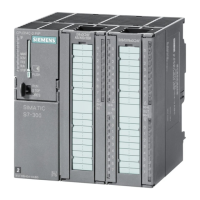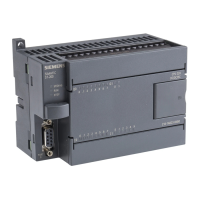Program instructions
7.3 Communication
S7-200 SMART
System Manual, 09/2015, A5E03822230-AC
185
3.
Idle line and start character:
The Receive instruction can start a message with the
combination of an idle line and a start character. When the Receive instruction is
executed, the receive message function searches for an idle line condition. After finding
the idle line condition, the receive message function looks for the specified start
character. If any character but the start character is received, the receive message
function restarts the search for an idle line condition. All characters received before the
idle line condition has been satisfied and before the start character has been received are
ignored. The start character is placed in the message buffer along with all subsequent
characters.
The idle line time should always be greater than the time to transmit one character (start
bit, data bits, parity and stop bits) at the specified baud rate. A typical value for the idle
line time is three character times at the specified baud rate.
Typically, you use this type of start condition when there is a protocol that specifies a
minimum time between messages, and the first character of the message is an address
or something which specifies a particular device. This is most useful when implementing
a protocol where there are multiple devices on the communications link. In this case the
Receive instruction triggers an interrupt only when a message is received for the specific
address or devices specified by the start character.
Setup: il = 1, sc = 1, bk = 0, SMW90/SMW190 > 0, SMB88/SMB188 = start character
4.
Break detection:
A break is indicated when the received data is held to a zero value for a
time greater than a full character transmission time. A full character transmission time is
defined as the total time of the start, data, parity and stop bits. If the Receive instruction is
configured to start a message on receiving a break condition, any characters received
after the break condition are placed in the message buffer. Any characters received
before the break condition are ignored.
Typically, you use break detection as a start condition only when a protocol requires it.
Setup: il = 0, sc = 0, bk = 1, SMW90/SMW190 = don't care, SMB88/SMB188 = don't care
5.
Break and a start character:
The Receive instruction can be configured to start receiving
characters after receiving a break condition, and then a specific start character, in that
sequence. After the break condition, the receive message function looks for the specified
start character. If any character but the start character is received, the receive message
function restarts the search for a break condition. All characters received before the break
condition has been satisfied and before the start character has been received are
ignored. The start character is placed in the message buffer along with all subsequent
characters.
Setup: il = 0, sc = 1, bk = 1, SMW90/SMW190 = don't care, SMB88/SMB188 = start
character

